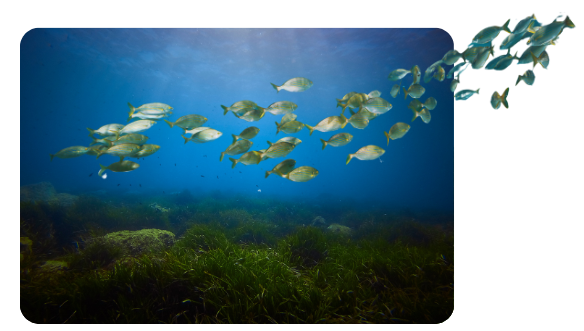Story
Celebrating the Western Channel Observatory on World Ocean Day
09 June 2023
For this years’ World Ocean Day we are celebrating the wonderful work of the Western Channel Observatory, hosted at Plymouth Marine Laboratory in partnership with the Marine Biological Association and funded by the Natural Environment Research Council.

What is the Western Channel Observatory?
The Western Channel Observatory (WCO) is a collection of sampling sites in the Western English Channel, off the coast of Plymouth, UK. Marine data collection in this area dates back to 1903 and is the longest running, near-continuous marine dataset in the world.
The WCO is a truly interdisciplinary operation and draws in expertise from ecologists, biologists, chemists, physicists, ecosystem modellers and Earth observation scientists. The data and knowledge generated at the WCO allows us to better understand the causes and consequences of some of the largest environmental issues we are currently facing, such as climate change, ocean acidification, biodiversity loss and pollution. This is achieved by measuring the key environmental and biological variables that are crucial to the functioning of the marine ecosystems. These include:
- Light
- Temperature
- Salinity
- Oxygen
- Organic and inorganic carbon
- Organic nutrients
- Biodiversity, from microbes to plankton and seabed macrofauna
- Atmospheric gases
In-situ measurements are taken weekly at a coastal sampling station L4 (measurements since 1988 at 50° 15’N; 4° 13’W) and fortnightly at the open shelf sampling station E1 (measurements since 1903 at 50° 02’N; 4° 23’W), with seabed samples taken every month. These are carried out aboard the RV Plymouth Quest.
These direct sampling activities are complimented by two state-of-the-art buoys, which send near-real time data back to Plymouth Marine Laboratory on environmental conditions, such as sea surface temperature, salinity, oxygen, turbidity, air temperature, humidity, windspeed, wind direction, atmospheric pressure, coloured dissolved organic matter (CDOM) fluorescence, nitrate and light.
In addition to the in-water sampling, there is an atmospheric chemistry observatory located at the mouth of Plymouth Sound, which monitors gases such as carbon dioxide, sulphur dioxide, ozone, and methane in air. The land-based observatory is in close proximity to the WCO marine sampling stations, enabling better understanding of the ocean-atmosphere gas exchanges.
The various aspects of the WCO combined with the long-term knowledge of this body of water also provides an exceptional test site for developing and calibrating new monitoring technologies. This is enabled by Smart Sound Plymouth.
The WCO is also embracing novel technologies that will allow the observation of biodiversity more quickly and efficiently than ever before. New in-water microscopes that can capture images of plankton are being deployed at some of the main sampling stations, with Artificial Intelligence being used to rapidly turn those images into useful biodiversity data. Molecular tools are also being used to sample the environment DNA that is in the ocean and on the seabed. This provides us with evidence of species that are hard to capture with traditional sampling.
Why are we celebrating the Western Channel Observatory on World Ocean Day?
This unique and highly valuable dataset brings together a plethora of scientific disciplines and is an exemplar for long-term marine monitoring and collaborative ocean science.
The WCO has global significance as an integral part of an international, directed observation effort to help improve our understanding of the ocean, how it functions and how those functions may be affected by environmental and climate change.
It has also been the location for considerable pioneering and world-changing science, such as the early marine plastic pollution research, which helped raise the profile of this ubiquitous and concerning environmental issue internationally as well as being the site of many novel experiments focused on tackling the issue.
Prof. Steve Widdicombe, Director of Science at Plymouth Marine Laboratory, commented on the importance of the WCO:
“We are very proud to manage such an important resource, not only for marine scientists locally but for environmental scientists across the globe.”
“The area of the WCO is one of the most studied bodies of water in the world. This has enabled an extensive understanding to be built on the functions and processes of the western English Channel’s dynamics, as well as providing an unrivaled case study reference site for international research.”
Prof. Tim Smyth, lead scientist of the WCO, added:
“There are multiple reasons why the WCO is unique and so valuable, including: the longevity of the dataset; the breath of science across domains; the inclusion of key ecosystem variables at all levels of the marine food web, and clear seasonal differences between the well-mixed autumn/winter water column and the more stable, layered spring/summer water. But it doesn’t stop there. The data is then fed into ecosystem models and satellite algorithms as well as being used for validation and calibration of monitoring technologies. This end-to-end analysis enables us to understand the physical, chemical and biological processes in the ocean, whilst identifying long-term trends and predicting future changes.”
During the week of World Ocean Day we will be sharing some of the fantastic science and other achievements that have been made possible by the WCO so take a look at PML’s social channels.

Related information
Western Channel Observatory (WCO)
Time-series: a collection of data points that are recorded in chronological order over a period of time. These data points are usually taken at regular intervals, such as seconds, minutes, hours, days, weeks, or years. Time-series data can be used to analyse and understand trends, patterns and relationships in data over time. It can also provide insights into how different variables change over time and how they may be related to each other.
